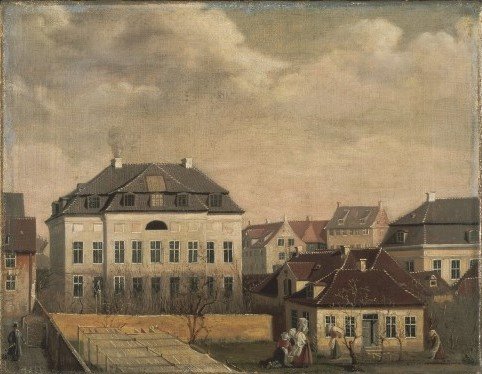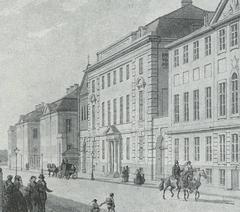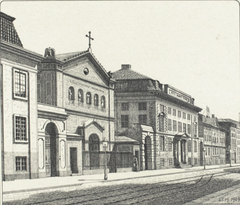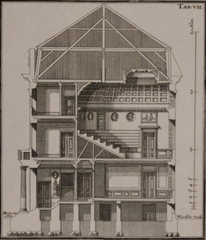
Medical Museion Copenhagen: Visiting Hours, Tickets, and Historical Significance
Date: 14/06/2025
Introduction
The Medical Museion in Copenhagen is a remarkable institution that bridges the historical evolution of medicine with current biomedical research and societal dialogue. Housed in an elegant 18th-century Neoclassical building—originally constructed as the Royal Academy of Surgery—the museum offers a unique experience for visitors interested in the intersections of science, history, and culture (Atlas Obscura; Niels Bohr Institute). Its layered significance extends from architectural grandeur and academic legacy to being the childhood home of Nobel laureate physicist Niels Bohr, who conducted his earliest scientific experiments within its walls.
Since its founding in 1907, the Medical Museion has curated an extensive collection of medical artifacts, anatomical specimens, and historical documents that span more than two centuries (Museion Official Website; Medical Museion – About Us). Integrated into the University of Copenhagen in 1918, the museum now serves as a dynamic center for research, education, and public engagement, offering exhibitions that explore themes ranging from the mind-gut connection to the history of epidemics. Its central location at Bredgade 62 makes it easily accessible for both residents and tourists.
This comprehensive guide explores the Medical Museion’s origins, collections, visitor information, and its lasting impact on the understanding of health, disease, and the human body.
Table of Contents
- Introduction
- Historical Background and Architectural Legacy
- Foundation and Development of the Museum
- Collections and Key Exhibitions
- Educational and Public Engagement
- Visitor Information
- Contemporary Relevance and International Recognition
- Timeline of Key Events
- Frequently Asked Questions (FAQ)
- Conclusion
- References and Further Reading
Historical Background and Architectural Legacy
Located at Bredgade 62, the Medical Museion’s building was constructed between 1785 and 1787 as the Royal Academy of Surgery (Kirurgisk Akademi). This institution played a pivotal role in professionalizing surgical education in Denmark, with the central auditorium specifically designed for anatomical dissections and lectures—a testament to the era’s dedication to hands-on learning (Atlas Obscura; Niels Bohr Institute).
The site’s importance is enriched by its association with Christian Bohr, a renowned physiologist, and his family. Notably, Niels Bohr, the Nobel Prize-winning physicist, grew up here and conducted his first experiments in the physiology laboratory behind the Academy (Niels Bohr Institute).
Foundation and Development of the Museum
Established in 1907 to mark the 50th anniversary of the Danish Medical Association, the Medical Museion was created to collect and display artifacts that documented the development of medical science in Denmark. In 1918, the museum became part of the University of Copenhagen, ensuring its status as a center for both scholarly research and public education (Atlas Obscura; Museion Official Website).
Collections and Key Exhibitions
Historical Artifacts and Specimens
The museum’s collection is among the largest in Europe, encompassing surgical instruments, anatomical models, preserved organs, and rare medical texts. Its holdings trace the development of medicine from the 18th century to the present, including human remains historically used in medical education (Atlas Obscura).
Notable Exhibitions
- Mind the Gut: Explores the complex relationship between the brain and the digestive system through a combination of historical artifacts, scientific research, and contemporary art.
- The Body Collected: An extensive collection of human remains, illustrating the evolution of medical research and ethical debates on the use of human tissue.
- Thematic Exhibitions: Topics such as epidemics (“Corona bliver også historie en dag”), dental history (“TÆNDER”), and technological advances in medicine.
Exhibitions are designed to provoke reflection on the cultural and ethical dimensions of medical practice (Museion Official Website).
Educational and Public Engagement
As part of the University of Copenhagen, the Medical Museion plays a key role in teaching and outreach. It offers guided tours, workshops, lectures, and interactive experiences designed to foster critical thinking about the history and future of medicine (Museion Official Website). Programs such as “Åben Samling” (Open Collection) allow supervised handling of objects, deepening the connection between visitors and medical history.
The museum also collaborates with artists, scientists, and historians to create interdisciplinary exhibitions and public events, encouraging dialogue on medical ethics, public health, and scientific innovation.
Visitor Information
Visiting Hours
- Tuesday to Sunday: 11:00 AM – 5:00 PM
- Closed on Mondays and public holidays
- Check the official website for seasonal changes or special closures.
Tickets and Admission
- Admission: Free for all visitors, including students and children. Donations are welcome (Museion Official Website).
- Guided Tours: Free guided introductions are offered in Danish and English during opening hours. Group tours and educational visits should be booked in advance.
Accessibility
The building’s historic nature presents some accessibility challenges, such as steep stairs and limited elevator access. However, the museum offers bilingual exhibition texts and guided introductions. Visitors with mobility concerns are encouraged to contact the museum in advance (Visitor Information).
Location and Directions
- Address: Bredgade 62, 1260 Copenhagen K, Denmark
- Nearest Metro: Kongens Nytorv (about 10 minutes’ walk)
- Bus Lines: 1A, 2A, and 26 stop nearby
- Parking: Limited nearby; public transport is recommended
Nearby Attractions
Combine your visit with other central Copenhagen sites such as:
- Nyhavn waterfront
- Amalienborg Palace
- The National Gallery of Denmark (Statens Museum for Kunst)
- The Round Tower (Rundetårn)
Tours and Photography
- Guided Tours: Highly recommended for a deeper understanding of exhibitions; advance booking advised for groups.
- Photography: Permitted in most areas for personal use (no flash or tripods). Some exhibits, especially those with sensitive content, may have restrictions.
Contemporary Relevance and International Recognition
The Medical Museion is an active participant in documenting and interpreting contemporary health challenges, such as the COVID-19 pandemic (Collecting the Corona Epidemic). Through exhibitions and collections, the museum reflects on how medicine shapes—and is shaped by—culture and society.
Internationally recognized for innovative science communication, the museum has received awards such as the UMAC Award, VISION exhibition award, Dibner Award, and MiD’s dissemination award (Medical Museion – About Us). Its name, “Museion,” reflects its Greek roots as a place of inquiry, collections, and teaching (Medical Museion – About Us).
Timeline of Key Events
- 1785–1787: Royal Academy of Surgery constructed at Bredgade 62
- 1886–1911: Home of Christian and Niels Bohr
- 1907: Museum founded to mark Danish Medical Association’s 50th anniversary
- 1918: Integrated into University of Copenhagen
- 1948: Official relocation to Bredgade 62
- 21st Century: Expansion of exhibitions, research, and public engagement (Niels Bohr Institute; Museion Official Website)
Frequently Asked Questions (FAQ)
What are the Medical Museion’s visiting hours?
Tuesday to Sunday, 11:00 AM – 5:00 PM; closed Mondays and public holidays.
How much do tickets cost?
Admission is free. Donations are appreciated.
Are guided tours available?
Yes, free guided introductions are offered in Danish and English. Group tours require advance booking.
Is the museum wheelchair accessible?
Some areas have limited accessibility due to the historic building. Contact the museum in advance for assistance.
Can I take photos inside the museum?
Photography is allowed in most areas for personal use, but restrictions may apply in some exhibitions.
Is the museum suitable for children?
Yes, with special programs and treasure hunts for families. Some exhibits involving human remains may not be suitable for young children.
Conclusion
The Medical Museion Copenhagen stands as a singular destination for exploring the history, science, and societal impact of medicine. Its combination of architectural heritage, rich collections, innovative exhibitions, and commitment to education and public engagement makes it a must-visit for anyone interested in the story of medicine. Whether you are a professional, student, or traveler, the museum offers a thoughtful and immersive experience.
For up-to-date information on visiting hours, ticketing, and special events, visit the official Medical Museion website. Enhance your visit with guided tours and explore nearby Copenhagen attractions to make your cultural journey complete.
References and Further Reading
- Medical Museion Copenhagen: Visiting Hours, Tickets & History of Copenhagen’s Medical Museum, 2024, Atlas Obscura (Atlas Obscura)
- Historical Sites at Bredgade 62, 2024, Niels Bohr Institute (Niels Bohr Institute)
- About Medical Museion, 2024, Medical Museion Official Website (Medical Museion – About Us)
- Visiting Medical Museion: Hours, Tickets, and Exploring Copenhagen’s Medical Heritage, 2024, Medical Museion (Museion Official Website)
- Collecting the Corona Epidemic, 2024, Medical Museion Research (Collecting the Corona Epidemic)



























































































